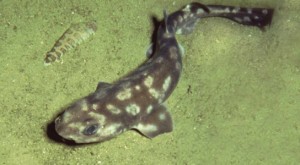Scientists discover a new species of shark in the Galapagos Islands
Friday, March 9th, 2012 4:51:48 by Taimoor Tariq
In a surprising search, deep-sea dives around the historic Galapagos Islands have discovered a new species of catshark which is about 1.3 feet long. The biological name of this species is Bythaelurus giddingsi and it was discovered by scientists
during a research.
The scientists were able to find as many as seven catsharks. Comparisons later on showed that the recently collected samples were actually a new species of sharks. These sharks have chocolate-brown skins with leopard-like spots that are randomly distributed
across their bodies.
Their most common relatives possess a dusky complexion with a straight line of spots.
Catsharks are also called dog fishes and are the largest known species of sharks. Scientists claim that the distribution of the spots is unique to the Galapagos Catshark as most of them have an identifying spot on one side which is smaller, larger or differently
shaped than the opposite-side spot.
These studies were later published in the journal Zootaxa. According to a research, more than 100 million sharks are killed all over the world each year.
In order to balance the ecosystem, sharks are a necessity being a top-level predator. Since the B.giddingsi has only been found on the Galapagos, it may be more vulnerable to extinction which means that these sharks should be protected and possibly farmed.
Johm McCosker of the California Academy of Sciences collected the first specimens of catsharks while diving into the depths of 1,400 to 1,900 feet aboard the Johnson Sea-Link submersible.
The recent discovery should not be really surprising considering that Galapagos Islands are known to house many different species of animals and fish that are yet to be discovered.
It was Charles Darwin who first discovered species of animals and plants that the world had never seen before. That was more than a 100 years ago so one can say that more discoveries could follow. Furthermore, these discoveries might go a long way in working
out how fish and animals at the Galapagos Islands, differ from those of other regions.
Tags: Bythaelurus giddingsi, catshark, committment, galapagos islands, shark, species
Short URL: https://www.newspakistan.pk/?p=15211

















